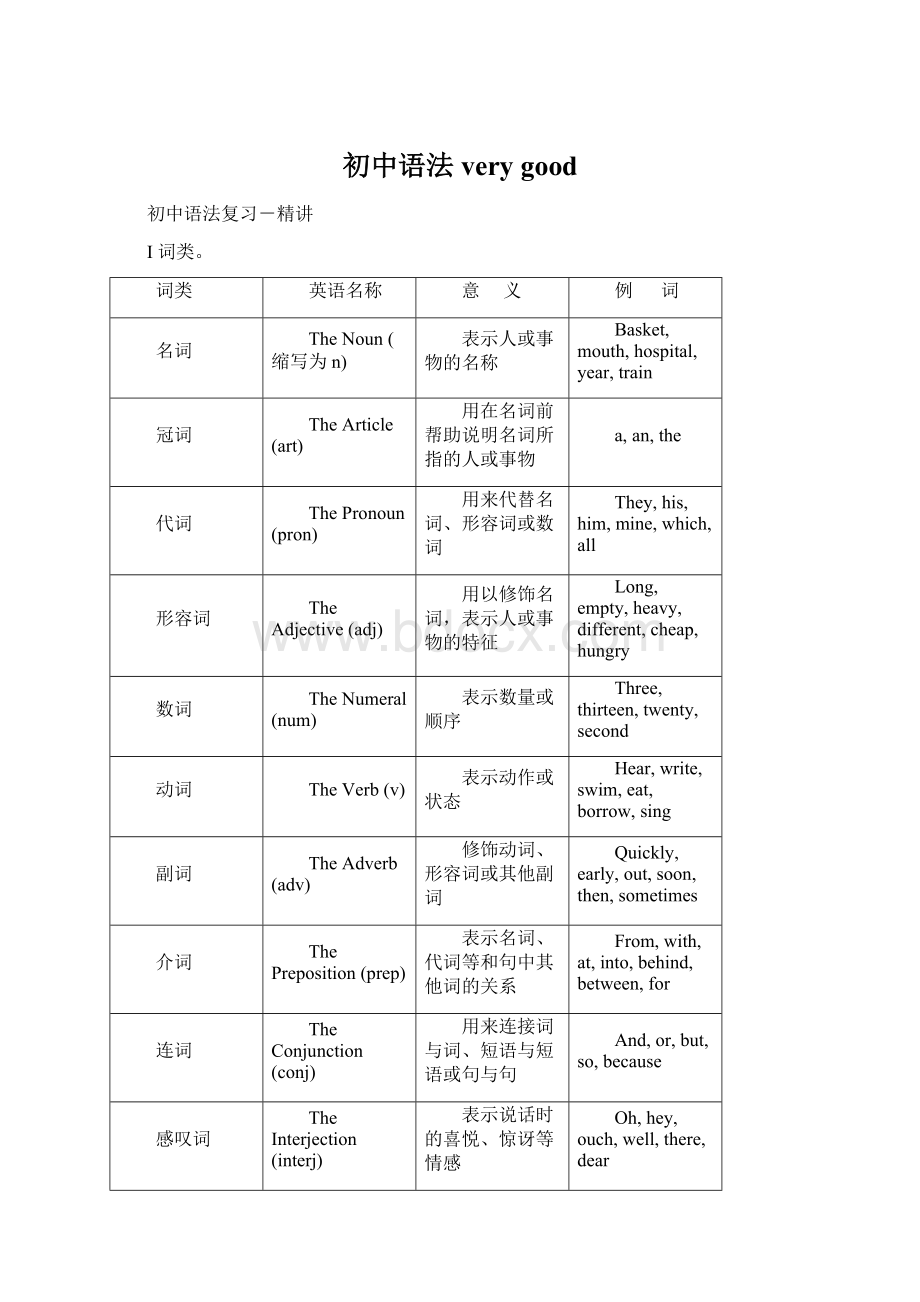初中语法very good.docx
《初中语法very good.docx》由会员分享,可在线阅读,更多相关《初中语法very good.docx(34页珍藏版)》请在冰豆网上搜索。

初中语法verygood
初中语法复习-精讲
Ⅰ词类。
词类
英语名称
意 义
例 词
名词
TheNoun(缩写为n)
表示人或事物的名称
Basket,mouth,hospital,year,train
冠词
TheArticle(art)
用在名词前帮助说明名词所指的人或事物
a,an,the
代词
ThePronoun(pron)
用来代替名词、形容词或数词
They,his,him,mine,which,all
形容词
TheAdjective(adj)
用以修饰名词,表示人或事物的特征
Long,empty,heavy,different,cheap,hungry
数词
TheNumeral(num)
表示数量或顺序
Three,thirteen,twenty,second
动词
TheVerb(v)
表示动作或状态
Hear,write,swim,eat,borrow,sing
副词
TheAdverb(adv)
修饰动词、形容词或其他副词
Quickly,early,out,soon,then,sometimes
介词
ThePreposition(prep)
表示名词、代词等和句中其他词的关系
From,with,at,into,behind,between,for
连词
TheConjunction(conj)
用来连接词与词、短语与短语或句与句
And,or,but,so,because
感叹词
TheInterjection(interj)
表示说话时的喜悦、惊讶等情感
Oh,hey,ouch,well,there,dear
(一)名词:
1.名词
专有名词:
表示人名、月份、日期、地名等。
如China,John,London,theUSA,Harbin.
个体名词:
表示单个的人或事物。
如boat,chair,desk,apple.
集体名词:
表示一群人或一些事物的总称。
如family,people,class,police.
物质名词:
表示无法分为个体的物质。
如water,air,tea,sea,money,cotton.
抽象名词:
表示抽象概念的词。
如health,help,work,friendship.
2.名词的数。
可数名词有单复数,不可数名词没有单复数。
3.名词的格:
名词有三个格:
主格(作主语)、宾格(作宾语)、和所有格。
其中只有名词的所有格有形式变化。
(二)冠词
1.定冠词-the.
1特指某(些)人或某(些)事物。
Thestudentsareverygood.
2说话人与听话人都知道的人或事物。
Whereisthetoilet?
3重复提到上文的人或事物。
Ihaveacat,thecatiswhiteandblack.
4表示世界上独一无二的事物。
Themoonmovesaroundtheearth.
5形容词最高级和序数词前和表示方位的名词前。
Iamtheoldest.Heisthefirsttoschool.Iliveinthesouth.
6乐器的名称前常用定冠词-the。
Ilikeplayingthepiano/violin.
7和某些形容词连用,使形容词名词化,代表某一类人。
Weshouldhelpthepoor.
8放在某些专有名词前。
WewillgotovisittheGreatWallnextweek. thepeople’sRepublicofChina.
9放在姓氏的复数形式前,表示全家人或夫妇两人。
TheWhitesarewatchingTV.
10固定词组中。
Inthemorning/afternoon/evening.
2.不定冠词-a/an.
1指人或事物的某一种类。
Ahorseisausefulanimal. Atablehasfourlegs.
2指某一类人或事物中的任何一个。
Passmeapencil,please. Wewritewithapen.
3指某人或某物,但不具体说明何人或何物。
Thebookwaswrittenbyapeasant. Lastmonthwewereworkinginafactory.
4不定冠词还可以指“事物的单位”,如“每日”、“每斤”等。
Hereisaletterforyou.Themeatis18yuanakilo.
3.零冠词。
1泛指人类或男女。
Manwillconquernature.
2抽象名词在用来表示它的一般概念时,通常不加冠词。
Knowledgebeginswithpractice.
3有些个体名词有时可以转化成具有抽象意义,其前面也常不加冠词。
Wehadbettersendhimtohospitalatonce.
4在专有名词前一般不用冠词。
Chinaisagreatcountry.MrSmithisanartist.
5在三餐饭何球类运动名称之前不用冠词。
Heoftengoesoutforawalkaftersupper. SometimesIplaybasketball.
6在节假日、星期几、月份、季节等名词前。
October10thisTeachers’Day.
7称呼语或表示头衔、职务的名词前不用冠词。
Grannyissleepingnow. Wecallhimmonitor.
8在语言名词前,名词前有指示代词、物主代词或数词时,不用冠词。
Thisishisbook. IcanspeakEnglish.
9不用冠词的惯用语。
Atnight/onfood/gototown/athome/inclass/atwork等。
(三)形容词
1.形容词的构成。
1简单形容词由一个单词构成。
Good,long,green,large,bright,interesting,surprised,learned,developing,sleeping.
2复合形容词由一个以上的词构成。
20-minute,second-hand,500-word,8-year-old,three-legged,round-trip,part-time,good-looking.
2.形容词的用法。
1修饰名词作定语。
Sheisabeautifulgirl.
2作表语。
Heisverystrong.
3作宾语补足语。
Letthedooropen. Youmustkeepyourclassroomclean.
4“定冠词+形容词”表示一类人或物,在句子中可作主语或宾语。
Weshouldspeaktotheoldpolitely.
5大多数形容词既可作表语又可作定语,但少数形容词只能作表语,不能作定语。
如:
asleep,ill,awake等。
6有些形容词只能作定语而不能作表语。
如:
many,little,wooden,golden等。
3.形容词的位置。
1形容词通常放在它所修饰的名词的前面。
Aheavybox.
2与表示度量的词连用,形容词要放在它所修饰词语的后面。
3metrelong. 12kilometeraway.
3与不定代词something,anything,everything,nothing等连用时,可以放在这些词之后。
Somethingimportant. nothingserious.
4当名词前有多个形容词修饰时,一般按下面的词序排列:
冠词(包括物主代词、序数词、基数词)-描述形容词(brave,beautiful)-表示形状(大小、长短、高矮)的形容词-表示年龄或新旧的形容词-表示颜色的形容词-表示国籍、出处或来源的形容词-表示材料、物质的形容词-表示用途或类别的形容词-被修饰的词。
Mynicesmallbrownleatherbag. thoselargeroundblackwoodentables.
4.形容词的比较级和最高级。
(一般加er/est,不规则见表)
1原级的用法:
“……和……相同”
A.肯定句:
A+动词+as+形容词原级+as+B. Heisastallasme.
B. 否定句:
A…+notas+形容词原级+as+B(即A不如B那么…)
A…+notso+形容词原级+as+B =A…+less+形容词原级+than+B.
2比较级的用法:
A.A+动词+形容词的比较级+than+B.(A比B更…,在这种句型中,比较级前面可用much,even,still,alittle,abit,alot,any,far等修饰,表示“…得多”,“甚至…”,“更…”,“…一点儿”。
B.“比较级+and+比较级”、“moreandmore+部分双音节或多音节的原级”译为“越来越…”。
3最高级的用法:
(个体用-of,范围用-in,最高级前面要用定冠词-the)
A.三种最高级表示法。
最高级:
ShanghaiisthelargestcityinChina.
比较级:
ShanghaiislargerthananyothercityinChina./ShanghaiislargerthantheothercitiesinChina.
原级:
NoothercityisaslargeasShanghaiinChina./NoothercityislargerthanShanghaiinChina.
(四)副词
1.副词的种类:
1时间副词:
often,always,usually,early,ago,already,before,ever,late,now,soon,since,tomorrow,justnow…
2地点副词:
here,there,above,below,outside,anywhere,back,down,home,out,everywhere…
3方式副词:
hard,well,badly,fast,slowly,angrily,simply,carefully…
4程度副词:
very,quite,much,still,almost,little,too,enough…
5疑问副词:
how,when,where,why…
6关系副词:
when,where,why…(引导定语从句)
7连接副词:
how,when,where,why,whether…
8频率副词:
often,seldom,usually,never,sometimes,everyday,always,hardly…
9其他副词:
really,certainly,surely,maybe…
2.副词的用法:
1作状语:
Hecanfinishtheworkeasily.
2作定语(要后置):
ThestudentsherearefromHarbin.
3作表语:
Imustbeoffnow.
4作宾补,构成复合宾语:
Showhimup. Isawhimoutwithmysisterlastnight.
3.副词的比较级和最高级。
(一般加er/est,不规则见表)
1副词的原级:
A. as+副词的原级+as “与…一样”
B.notas(so)+副词的原级+as “与…不一样”
C.too+副词的原级+todosth.“太…而不能”
D.so+副词的原级+that从句“如此…以致于…”
E.副词的原级+enoughtodosth.“足够…能做…”
2副词的比较级:
A.A+动词+副词比较级+than+B
B.副词比较级前也可以用much,even,still,far,any,alittle,abit,alot等修饰。
C.比较级+and+比较级,表示“越来越…”,themore…themore…表示“越…就越…”
D.副词的最高级前通常不加定冠词the.
(五)数词
1.基数词:
1-12
13-19
20-90
100-
1one
13thirteen
20twenty
100ahundred
2two
14fourteen
21twenty-one
300threehundred
3three
15fifteen
22twenty-two
1,000athousand
4four
16sixteen
30thirty
5,000fivethousand
5five
17seventeen
40forty
1,000,000amillion
6six
18eighteen
50fifty
1,000,000,000abillion
7seven
19nineteen
60sixty
8eight
70seventy
9nine
80eighty
10ten
90ninety
11eleven
12twelve
2.序数词:
1-10
11-19
20-90
100-
1first1st
11eleventh11th
20twentieth20th
100onehundredth100th
2second2nd
12twelfth12th
21twenty-first21st
103onehundredandthird103rd
3third3rd
13thirteenth13th
30thirtieth30th
134onehundredandthirty-fourth134th
4fourth4th
14fourteenth14th
37thirty-seventh37th
200twohundredth200th
5fifth5th
15fifteenth15th
40fortieth40th
1000onethousandth1,000th
6sixth6th
16sixteenth16th
50fiftieth50th
1,000,000onemillionth1,000,000th
7seventh7th
17seventeenth17th
60sixtieth60th
1,000,000,000onebillionth1,000,000,000th
8eighth8th
18eighteenth18th
70seventieth70th
9ninth9th
19nineteenth19th
80eightieth80th
10tenth10th
90ninetieth90th
1作主语:
Thefirstisbetterthanthesecond.
2作宾语:
Hewasamongthefirsttoarrive.
3作表语:
Heisthefirsttocometoschool.
4作定语:
Theninthletteroftheword“restaurant”is“n”./Therearethreethousandworkersinthefactory.
(六)代词
类 别
作 用
例 词
例 句
人称代词
代替人或事物,主格作主语,宾客作宾语
数
格 人称
单 数
复 数
Iamateacher.
Theyarestudents.
Wealllikehim.
Hegavethebooktome.
一
二
三
一
二
三
主格
I
you
he
She
it
we
you
they
宾格
me
you
him
Her
it
us
you
them
物主代词
形容词性只作定语,名词性可以作主、宾、表语等,表示所属关系
词义
类型
我的
你
的
他的
她
的
它
的
我们的
你们的
他们
的
Mybookisthere.
Herfatherisaworker.
Thisbikeisyours,oursisbroken.
形容词性
my
your
his
her
its
our
your
their
名词词性
mine
yours
his
hers
its
ours
yours
theirs
反身代词
起强调作用,只作同位语和宾语
数 人称
第一人称
第二人称
第三人称
Weourselvesdidthework.
Hedidtheworkbyhimself.
单 数
myself
yourself
himself
herself
itself
复 数
ourselves
yourselves
themselves
相互代词
表示相互关系,作宾语
宾 格
所 有 格
Weshouldhelpeachother.
Pleasecorrecteachother’smistakes.
eachother(两者相互)
eachother’s(相互的)
oneanother(三者或三者以上)
oneanother’s(相互的)
指示代词
起指示作用,作定语、主语、宾语、表语等
This,that,these,those,it,such,same
Takethisbooktohisroom.
Mypointisthis.
不定代词
代替或修饰任何不定数量及不定范围的人或事物
some,any,no,none,many,few,little,all,both,every,one,either,neither,other,afew,alittle,another,somebody,nobody,nothing,each
Ihavesomethingtotellyou.
Neitheranswerisright.
疑问代词
表示疑问,构成特殊问句
who,what,whose,which,whom
Whomdidyousee?
关系代词
引导定语从句
which,that,who,whom,whose
ThebookthatIlostwasnew.
连接代词
引导名词性从句(主语从句、宾语从句、表语从句、同位语从句)
what,who,that
Iknowwhatyouaredoing.
That’swhatIhope.
(七)动词
类 别
意 义
例 子
例 句
行为动词
含有实在的意义,表示动作或状态,在句中能独立作谓语。
及物动词
后面一定接宾语
Open,vis